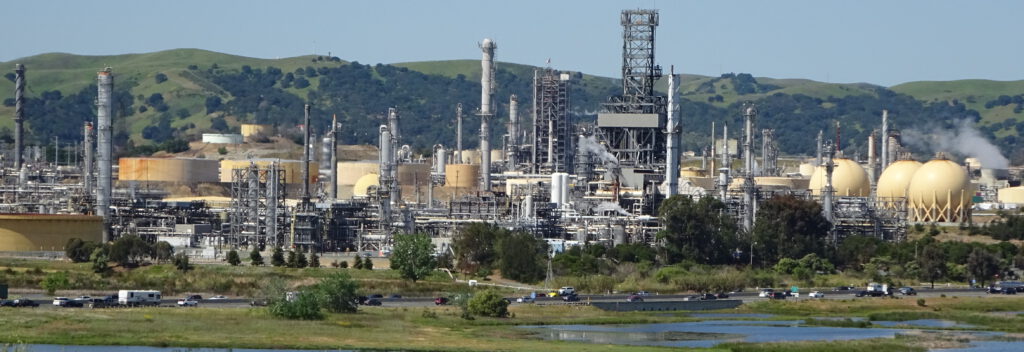Dr Gwen Ottinger, Assistant Professor, Department of Politics, Drexel University, USA
The EPA refinery rule thus marks a major victory in community groups’ decades-long struggle for ambient air monitoring at refinery fence lines… but without a way to translate new air quality information into action, communities risk being overwhelmed by data.
On September 29, 2015, the United States Environmental Protection Agency (EPA) issued a new rule aimed at controlling air pollution from oil refineries. Grassroots groups representing communities adjacent to refineries in Louisiana, Texas, and California had pushed for the rule, suing the agency to update its refinery regulations. When the rule was released, they heralded it as a victory for community health, highlighting one provision in particular: the new requirement that refineries monitor for benzene concentrations at their fencelines.
It’s hard to appreciate the significance of this provision—widely hailed as the “first-ever” fenceline monitoring requirement—without understanding just how little air monitoring is conducted in fenceline communities, and how active residents have been in advocating for more.
When I first began studying community activism around oil refineries, I was shocked to learn that there was virtually no systematic monitoring of ambient air quality at refinery fencelines or in neighboring residential areas. Refineries monitor their emissions, and they use computer models to calculate their effects on the ambient air. But air dispersion models, as they’re called, have their limitations: they don’t include ground-level “fugitive emissions” from leaky seals and valves, and they don’t model the effects of emissions from accidental releases.
Community advocacy for fenceline monitoring was catalyzed by a 1994 accident at the Unocal Refinery in Rodeo, California. A release went unreported and unchecked for 16 days, sickening hundreds of residents. In the aftermath, community members fought for—and won—a continuous, real-time, fenceline monitoring system. Their lawyer also commissioned an engineering firm to design an inexpensive, easy-to-use air sampler that would allow residents to generate their own air quality data when they detected a problem. The community-friendly “bucket” air sampler quickly spread to refinery communities around the world, and users presented their data alongside calls for more extensive, real-time monitoring, holding up the fenceline system as a gold standard.
The EPA refinery rule thus marks a major victory in community groups’ decades-long struggle for ambient air monitoring at refinery fencelines. It guarantees that every community will have access to at least some information about actual, local concentrations of a known carcinogen.
At the same time, however, activists decry the limited scope of the monitoring required: it includes only one chemical, and it doesn’t offer real-time readings that could give residents insight into what they are breathing during an obvious accident or release. Instead, samples will be collected over two-week periods—meaning that an intensely high concentration that lasts for an afternoon would show up as only a slight elevation in the two-week average—and refineries judged on 6-month average concentrations.
U.S. refinery rules thus underscore an important, unfolding dynamic in our efforts to understand the “slow violence” of toxic exposures.
Community groups and their allies would have preferred to see the EPA adopt fenceline monitoring rules more like those currently proposed by the Bay Area Air Quality Management District in Northern California, where regulators are calling for refineries to install real-time monitoring for an array of chemicals, with data to be made available immediately on a public website.
But even real-time monitoring cannot, in and of itself, protect community health or improve air quality. Without a way to translate new air quality information into action, communities risk being overwhelmed by data. Though limited in other ways, the EPA’s rule recognizes this: it sets an action level for benzene. If measured concentrations exceed the action level at a refinery’s fenceline, the company is required to take additional measures to identify and fix the source(s) of the emissions. In contrast, the Bay area rule requires only that data be collected and made accessible to residents. The work of sifting through the data, identifying potentially unhealthy exposures, and fighting for enforcement and remediation, falls on community groups, who may not have the capacity to handle such large volumes of data.
U.S. refinery rules thus underscore an important, unfolding dynamic in our efforts to understand the “slow violence” of toxic exposures. Many of the most important victories in the fight against toxins have revolved around securing the “right to know” and winning access to information. But with data becoming easier and easier to generate, store, and make available, there’s a real risk that right-to-know provisions will lead to information overload rather than new knowledge or meaningful environmental improvements. Although struggles for access to data are far from over, the next wave of advocacy needs to incorporate a concern for how to leverage data to drive change; the next wave of innovation should focus on “gold standard” and community friendly information systems that enable residents and regulators to put toxic data to work in the protection of fenceline communities.
(Featured image: credit Gwen Ottinger)
